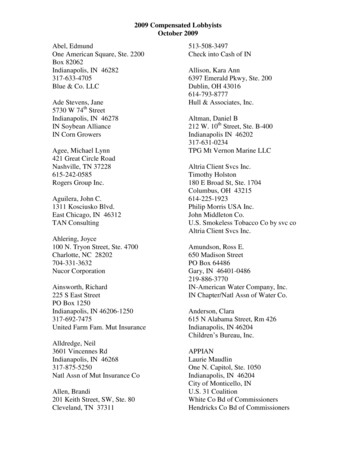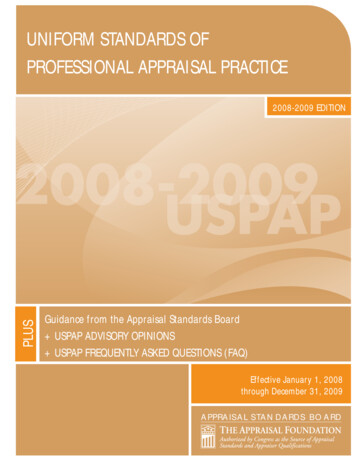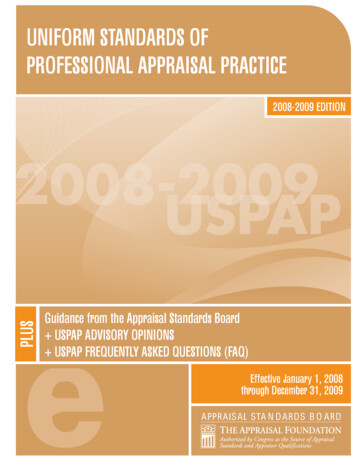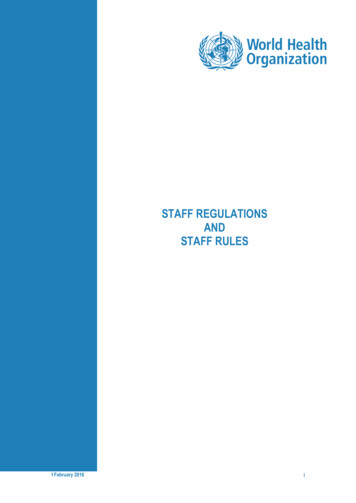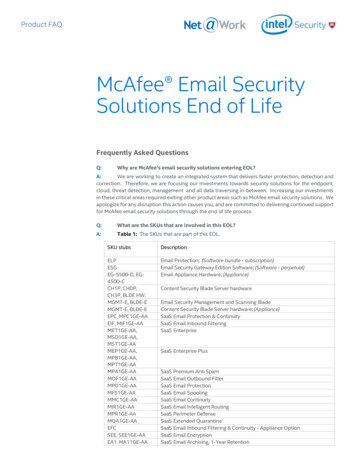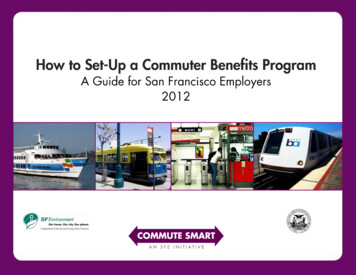
Transcription
Effective January 19, 2009, the San Francisco Commuter Benefits Ordinance requires businesses with locations in SanFrancisco and 20 or more employees nationwide to offer commuter benefits to their employees.This guide assists local employers, from small businesses to large corporations, implement a commuter benefits program foremployees. The steps laid out in this guide help to develop a program that best fits with a company’s values, budget andemployee preference.This guide is assembled by the San Francisco Department of the Environment’s Commute Smart Program as part of aneffort to encourage walking, biking, taking transit and ridesharing to and home from work. For more information onCommute Smart programs and services, call (415) 355-3727 or email CommuteSmart@sfgov.org.
BackgroundPages 1 - 4What are Commuter Benefits?What are the Advantages?What is the San Francisco Commuter Benefits Ordinance?Set Up Your ProgramPages 5 - 13Steps to Setting-Up a Pre-Tax Benefit or Employer-Paid SubsidySteps to Setting-Up an Employer-Provided Shuttle ServiceThe Final StepAdditional DocumentsPages 14 - 21Glossary of TermsVendor DirectorySample Employee Survey*Sample Employee Enrollment Form*Sample Employee Paycheck Insert*Sample Flyer & Email Announcement** Also available as an individual Word document (.doc)
What are Commuter Benefits?Commuter Benefits are federally approved employer-provided incentives for employees to reduce their monthlycommuting expenses for transit, vanpool, biking and parking (IRS code 132(f)).1 Companies can offer employees a:Pre-tax employee-paid payroll deduction,Tax-free employer-paid subsidy,Employer-provided shuttle service, orCombination of the aboveWhat are the Advantages?Tax advantagesooEmployees can commute by transit, rideshare or bike at a lower cost than if they paid the cost out of pocket.If employees drive less, other benefits include reduced stress and lower auto maintenance expensesOrganizations realize savings through reductions in FICA, Medicare, Federal Income and State Income taxesHealthier and more productive employeesoooEmployees who bike or walk to work are healthier, reducing health insurance claims and sick leaveCommuter benefits have proven to be a cost-effective tool for increasing job satisfaction and helping recruitand retain talentEmployees who walk, bike, take transit or rideshare often arrive at work relaxed, less stressed from trafficcongestion and ready to be productive, boosting morale and enhancing the work environmentAn organization that provides commuter benefits is recognized as a good community leader and neighborooo1The award for the Best Workplaces for Commuters is given to organizations that offer commuter programsand meet the National Standard of Excellence criteria. Join other San Francisco Bay Area employers inattaining this mark of excellence in environmental leadershipThe US Green Building Council (USGBC) provides Leadership in Energy and Environmental Design (LEED)credits for implemented alternate transportation effortsBy encouraging commuting by a variety of transportation options, commuter benefits help reduce trafficcongestion and improve air quality, making our cities and regions better places to liveTo see the full federal regulations, please visit the IRS’ Employer’s Tax Guide to Fringe Benefits (Publication 15-B).
Save on parking needsoAs more employees use a variety of transportation modes, less parking is needed. Organizations can reinvestthe savings back into the companyThousands of employers in San Francisco and across the country already offer commuter benefits to their employees. Thisguide assists you in becoming one of these benefit-savvy employers.What is the San Francisco Commuter Benefits Ordinance?Effective January 19, 2009, the San Francisco Commuter Benefits Ordinance requires businesses with locations in SanFrancisco and 20 or more employees nationwide to offer a Commuter Benefit to their employees. To comply, employersmay offer their employees a pre-tax employee-paid benefit, an employer-paid transportation benefit, an employerprovided shuttle service or a combination of these options.Employers are required to submit an annual Compliance Form to the Commute Smart program at the San FranciscoDepartment of Environment by April 30th of each year. Non-compliance will result in a fine: 100 for a first violation, 200 fora second violation within the same year, 500 for each additional violation within the same year.Please visit CommuterBenefits.org to submit your annual Compliance Form or to learn more about the non-complianceenforcement process.How Can My Organization Comply with the Ordinance?The San Francisco Commuter Benefits Ordinance specifies three primary benefit options:1) Pre-Tax Employee-Paid Benefit2) Employer-Paid Subsidy3) Employer-Provided Shuttle Service1. Pre-Tax Employee-Paid Benefit:Through their paycheck, employees have the option to set aside pre-tax funds each month to pay for their transit, vanpooland parking expenses. By doing so, taxable income is reduced, translating into travel savings for employees of up to 40%.As a result, business payroll taxes decrease, from saving up to 9% for each employee participating in the benefit.
A savings calculator helps to illustrate the FICA savings a business could generally experience through commuter benefits.The more employees that participate, the greater the savings to the employer. See Figure 1 for an illustration of employersavings based on employee deductions of 115/month.Please note that effective January 1, 2012, the IRS pretax limit is 125/month for transit and vanpoolexpenses and 240/month for parking expenses,including parking at or near public transportation.2Figure 1: Employer payroll savings based on number of employees participatingin the commuter benefits programEmployers Savings by # of Employees*EmployeesDeductions perMonthDeductions perYearPayroll Savingsper Year1 115.00 1,380.00 105.575 575.00 6,900.00 527.8520 2,300.00 27,600.00 2,111.4050 5,750.00 69,000.00 4,590.00* Based on: employee deductions of 115/month; tax rates of 7.65% FICA &Medicare, 28% Federal Income Tax, 6% State Income Tax. Actual tax savingsdepend on individual and employer’s tax rates.2. Employer-Paid SubsidyThrough this option, a business can subsidize employee transit, vanpool or bicycle commuting costs. As with the EmployeePaid Benefit, businesses do not pay payroll taxes and employees do not pay income taxes on the benefit amount. Thisbenefit is a cost-effective option as compared to a pay raise of the equivalent dollar value (See Figure 2).Figure 2: Comparison of taxable salary increase to employer-paid tax-free commuter benefit of 100 100 Tax-Free Commuter Benefit 100 Salary Increase 100Employer paysFICA; getscorporate incometax deductionEmployee paysFICA, federal &state incometaxesEmployerpays 71EmployerEmployeeEmployeetakes home 58 100Employer doesnot pay FICA; getscorporate incometax deductionEmployeetakeshome full 100Employerpays 66EmployerEmployeeSource: Transportation Research Board. “Strategies for Increasing the Effectiveness of Commuter Benefits Programs.” Transit Cooperative Research ProgramReport 87. http://onlinepubs.trb.org/onlinepubs/tcrp/tcrp rpt 87.pdf (accessed March 2012).2See page 13 of the full text on the 2012 IRS limits.
A transit or vanpool subsidy, unless offered in combination with the Pre-Tax Employee-Paid Benefit, must be of equivalentvalue to the San Francisco Muni Fast Pass ‘A’ (currently 72/month). Bicycle commuters may be offered a subsidy up to 20/month to cover bicycle maintenance and repairs, provided that they do not receive a transit benefit.Employers may decide on a subsidy of a lesser value if offered in tandem with pre-tax deductions. For example:Employer provides a 40/month subsidy, and sets up a pre-tax deduction program for employeesIn addition to receiving the 40 subsidy, employee chooses to have 50/month deducted pre-tax from theirpaycheckEmployee receives a total benefit of 90/month to use towards their transit or vanpool expenses3. Employer-Provided Shuttle ServiceEmployers may provide a shuttle service using a bus or van between employee residential areas or transit stations andplace of business. This may be a good option for employers with a large number of employees who are concentrated in afew geographic areas.
Getting Started1) Meet with Relevant Staff Within Your OrganizationDeciding which type of commuter benefits program to offer is a process that must involve upper management. Begin bychecking in with the relevant parties so that you are aware of the available budget and staff time and how this benefit willfit within company culture.Human Resources and payroll staff will also play a role in the program. Engage all relevant staff persons in conversationsabout the commuter benefits program as you begin to implement your program and moving forward.Staff Involved in developing and implementing a Commuter Benefits Program:If your business is located in the Downtown, Financial or Mission Bay areas of San Francisco, consider contacting yourtransportation management association (TMA) to determine the services available to assist with implementing a commuterbenefits program:Transportation Management Association of San Francisco: a non-profit organization committed to maximizingaccess and mobility to, from and within San Francisco. TMASF is comprised of more than 55 of San Francisco’s officebuildings in the downtown and financial districts that provide their tenants with transportation choices and support.Mission Bay Transportation Management Association: a non-profit organization committed to maximizing access andmobility to, from, and within the Mission Bay development area.2) Conduct a Transportation SurveyTo determine how many employees will participate and what their current commute looks like send a quick survey to youremployees. A sample survey is included at the end of this guide.Number of Employees Who Will Participate:Transit Agencies Used by Employees:
3) Decide Which Type of Benefit to OfferTo make decisions about your program you will need to coordinate with other departments within your organization,including payroll, human resources and upper management.Work with these parties to review the information gathered from the transportation survey (Step 2), and choose which typeof benefit your organization would like to offer. Factors that will affect the decision include: budget, employeetransportation preferences, number of interested employees, etc.The following benefits may be offered individually or in combination:Pre-Tax Employee-PaidEmployer-Paid SubsidyEmployer-Provided Shuttle ServiceMy Organization Will Offer Employees:If you would like to offer a Pre-Tax Employee Paid Benefit, an Employer-Paid Subsidy, or a combination continue to Step 4.If you are interested in setting up an Employer-Provided Shuttle program, continue to the Step-by-Step Guide.4) Administering the BenefitDepending on your organization’s size, budget, location, and staff resources you may choose to administer your ownCommuter Benefits program or contract with a vendor. Consider the results from your transportation survey and the tasksinvolved in administration (see Figure 3), and then choose which option is best for you.Note that Figure 3 provides recommendations only; specifics may vary depending on your organization’s needs.
Figure 3. Employer versus Vendor Administration of a Commuter Benefit ProgramTasks / RolesEmployer AdministrationVendor AdministrationEmployer:Employer:--Takes employee ordersMakes payroll deductions*Provides orders to vendorDistributes benefitAnswers employee questions about benefitConsWhich employersis this best for?Vendor:-Purchases benefit for employees--Minimal vendor fees ( 0- 5 per participant)-Minimal staff time for administration-Requires more staff time to coordinateadministration-Slightly higher vendor feesMay require minimum number of participants,depending on vendor-75 employees participating OR any size businesswith minimal management time availableEmployers already using a vendor foradministration of other benefits (e.g. medicalbenefits)Vendor:ProsMakes payroll deductions*Coordinates with vendor-Between 1 and 75 employees participatingSome time available for program management-Takes employee ordersPurchases benefit for employeesDistributes benefitAnswers employee questions about benefit* Does not apply to Employer-Paid Subsidy ProgramsIf your organization has fewer than 20 total employees, consider contacting the Commute Smart team to learn how acommuter benefits program can be tailored for small employers.5) Talk to VendorsA list of vendors is included in the Vendor Directory. Please contact the vendors for pricing information that is specific toyour organization’s needs.Possible questions for vendors include:1. What is the cost per participant?2. In what form does the benefit come? Vouchers, Clipper Cards, debit cards, etc?
3. When does the vendor need the money? (This will determine which paycheck(s) deductions are taken from)4. What information does the vendor need each month? When do they need it by? What format should it be in?5. Will the vendor distribute the benefit or do you need to do this?6) Coordinate Within Your OrganizationWork with upper management and payroll to decide on your program administration process.Possible questions for upper management include:1. Does your organization want to administer the benefit or do they want to share the administration with a vendor?In making this decision, remember to compare the time that employer administration will take a staff personeach month versus the cost of shared administration.2. If upper management decides on employer administration, who will be the appointed staff person to administerthe benefit?3. If upper management decides on shared or vendor administration, who will be the appointed staff person tocoordinate with the vendor?Possible questions for payroll include:1. How many pay periods do we have?2. How will we do payroll deductions? Do we need to set up a new deductions code?3. When do we want to deduct the money from employee’s paychecks?(Note that payroll may play a smaller role in an Employer-Paid Subsidy program, since no pre-tax deductions are needed.)After you have checked in with upper management and payroll, it is finally time to make a decision!My Organization’s Administration Method:Appointed Staff to Administer Benefit / Coordinate with Vendor:7) Create a Commuter Benefits PolicyCreate a written company policy to use as reference for employee questions. Distribute this policy to new and currentemployees who have signed up for the program. Include procedures or policies for:Important dates or deadlines (paycheck deductions, changes to benefit order, cancellation)
Reimbursement policy (note that IRS guidelines generally do not allow reimbursement of pre-tax funds)Lost voucher/pass/benefitWho employees can contact for more informationAvailability of funds when an employee terminatesNext Steps:Click on your chosen administration method:EMPLOYER Administration VENDOR Administration
Employer AdministrationYou’ve decided to self-administer your Commuter Benefits program. Your appointed staff person(s) will enroll employees,take employee benefit orders, use payroll deductions to order the transit benefit from a vendor, and distribute the benefits.1) Choose a Vendor to Order the Benefit FromChoose which vendor you’d like to order your transit-specific media (vouchers, debit cards, etc.) from so that you canadminister your program. Contact one of the vendors in the “Employer Administration” section of the Vendor Directory toconfirm logistics, including:Cost per participant, voucher, etc.Form of the benefit (Vouchers, Clipper Cards, Debit Cards, etc.)When vendor must receive pre-tax deductions or employer-subsidized benefit amount and order informationWhen you will receive benefitVendor:2) Set Up Pre-Tax DeductionsOnly for Pre-Tax or Combination ProgramsWork with your payroll administrator to set up a Commuter Benefit pre-tax deduction code. According to the informationyou have gathered from your vendor, you will already have determined when employees’ paychecks will be deducted.3) Employees Enroll in the ProgramCustomize and distribute our Sample Employee Enrollment Form to collect orders and to inform employees about importantprogram dates, including deadlines to change orders and the paycheck deduction dates. You will compile the employeeorder information into the format specified by your vendor.4) Place Benefit Order with Vendor & Distribute to EmployeesSend employee order information to the vendor. Distribute the commuter benefit to your employees according to theprocess you and your vendor have decided on. Don’t forget to periodically remind new and current employees thatCommuter Benefits are available to them!
Vendor AdministrationYou’ve decided to have a Vendor take on administration of your Commuter Benefits program!1) Choose a VendorYou have already spoken with vendors to ask them about their services and costs; it’s time to choose which you’d like tohelp you administer your program. Contact one of the vendors in the “Vendor Administration” section of the VendorDirectory to confirm program logistics, including:Cost per participantForm of the benefit (Vouchers, Clipper Cards, Debit Cards, etc.)When vendor must receive pre-tax deductions or employer-subsidized benefit amount and order informationHow the vendor will communicate employees to conduct program outreach, take orders, answer questions, etc.How the benefit will be distributed to employeesVendor:2) Set up Pre-Tax deductionsOnly for Pre-Tax or Combination ProgramsWork with your payroll administrator to set up a Commuter Benefit pre-tax deduction code. According to the informationyou have gathered from your vendor, you will already have determined when employees’ paychecks will be deducted.3) Vendor AdministratesThe vendor will work with your employees to take and distribute their Commuter Benefit orders, and with your payrolladministrator to collect their pre-tax paycheck deductions.While the vendor may reach out to new and/or existing employees to let them know about their Commuter Benefits, youmay also want to do your own program outreach.
Setting up an Employer-Provided Shuttle Service1) Familiarize yourself with local transportation options and other employer-provided servicesBefore you establish your own program, it will be helpful to know if any existing shuttle services are already serving or are inclose proximity to your workplace.Contact agencies or other companies for more information:511.org: Bay Area traffic, transit, rideshare, and bicycling informationTransportation Management Association of San Francisco: a non-profit organization committed to maximizingaccess and mobility to, from and within San Francisco. TMASF is comprised of more than 55 of San Francisco’s officebuildings in the downtown and financial districts that provide their tenants with transportation choices and support.Mission Bay Transportation Management Association: a non-profit organization committed to maximizing access andmobility to, from, and within the Mission Bay development area.Other employers who have established companywide shuttle service2) Map Employee Residential LocationsYou have already conducted a general transportation survey, so you have an idea of how many employees are interestedin participating in your commuter benefit program. However, to set up a shuttle service you will need more detailedinformation, including where employees commute from, what time they usually arrive to and leave work, what mode oftravel they use, etc. A sample survey can be found at 511.org.Using survey results, map employee residential locations to determine their density and proximity to transit, or contactCommute Smart for assistance. Medium to high density of employees in a location allows for more cost-effectivecommuter service. For example, some companies offer a commuter bus service leaving from the Mission District in SanFrancisco, as they found a high concentration of employees live in that area.If you would like assistance to conduct a survey and density map, contact CommuteSmart@sfgov.org.Number of Employees Who Will Participate:High Density Employee Locations:Nearby Transit Stations Used by Employees:
3) Determine specific strategies to implement.Now that you have gathered more information about your employees’ commuting habits, assess your workplace to get abetter idea of how to shape your program.If possible, partner with nearby companies to share costsIf you’ve found that many of your employees ride transit, start your shuttle program with a last mile shuttle thatprovides transportation from the nearest regional transit stop to the officeContract with charter bus companies: Companies are experienced in helping determine route and schedule and providedrivers, a variety of vehicles, and overall transportation expertise. Contractors in the Bay Area include Bauer’s, MVTransportation, Coach USA, and Veolia.My Implementation Plan:The Final StepOutreachNow that a program is implemented, employee outreach is critical to success and utilization. Consider using the followingoutreach techniques (samples of these documents are included at the end of this guide):a)b)c)d)e)f)Include Commuter Benefits in New Employee OrientationsPost flyers in high-visibility places (e.g. break rooms, the front desk, the HR department, the mailroom)Include a notice in employee paychecks, mailboxes, or on the IntranetSend out an email announcement to all employeesMake an announcement at an all staff meeting or relay the message through team managersUpdate your personnel policy handbookMy Outreach Plan:
Glossary of TermsBart High Value Ticket: A ticket with a 6.25% discount available in two denominations: a 48 ticket for 45 and a 64ticket for 60. These tickets now are only available by setting up the Autoload feature at clippercard.com. Learn more onbart.gov.Clipper Card: A Bay Area wide transit card, scheduled to become the main form of fare payment on all Bay Area transitagencies. Individual Clipper Cards can be registered and loaded with e-cash or transit passes at clippercard.com. TheAutoload feature at clippercard.com allows Clipper users to link a credit card to their Clipper Card so that a monthly passor e-cash is automatically loaded when the card balance gets low. Multiple Clipper Cards can be linked to one account.Muni Fast Pass: A monthly pass to ride Muni, San Francisco’s bus agency. The Muni Fast Pass “A” costs 72, and alsoallows the user to ride BART within San Francisco. The Muni Fast Pass “B” costs 62, and does not include BART travel.Pre-Tax Limit: The amount of pre-tax funds that can be deducted each month to be used towards transit or parking. Asof April 1, 2012, the pre-tax limit for transit/vanpool use is 125/month and the pre-tax limit for parking is 240/month.Rideshare: This form of commuting involves sharing motor vehicle transportation with others. A carpool is two to fivepeople riding together, while a vanpool is five to twelve people.Transit Card: A transit-specific debit card onto which employee transit benefits are loaded. The card can be used topurchase transit passes or add funds to a Clipper Card.Transit Voucher: A paper voucher for a specified dollar amount that can be used to purchase transit passes or loadedonto a Clipper Card.
Last updated 9/31/2011
Insert CompanyLogo HereCommuter Benefits Employee Interest Survey Edit this survey to fit your organization Dear Valued Employee,We are in the process of implementing a new employee benefit for transit and vanpool riders. To help us create aprogram to match your needs, we are conducting an interest survey. This is not an enrollment form.How would it work?By enrolling in the commuter benefits program, you could save money each month on your transit, rideshare orbicycle commute.1. Would you be interested in participating?YesNo2. How do you currently get to work? Circle all that apply.Personal CarTransitCarpool/VanpoolBikeWalkOther:3. If you ride transit, which transit agencies do you ride? Check all agencies that apply. AC Transit ACE Alameda Harbor Bay Ferry Alameda/Oakland Ferry American Canyon Transit Amtrak Angel Island-Tiburon Ferry BART Benicia Breeze Blue & Gold Fleet Caltrain County Connection Dumbarton Express Fairfield and Suisun Transit (FAST) Golden Gate Ferry Golden Gate Transit Hornblower Alcatraz Ferry Petaluma Transita. Does your transit agency accept the Clipper Card? Rio Vista Delta Breeze SamTrans San Francisco Muni Santa Clara VTA Santa Rosa CityBus Sonoma County Transit St. Helena VINE Tri Delta Transit Union City Transit Vacaville City Transit Vallejo Baylink Ferry Vallejo Transit VINE (Napa County) WestCAT WHEELS Yountville Shuttle Other:YesNob. If yes, would you want your commuter benefits order on a Clipper Card?Yesc. What benefit (pass/ticket/e-cash) would you order through Commuter Benefits?No
d. How much does this benefit (pass/ticket/e-cash) cost?Please complete this survey before enter date and return to enter contact name or office location . After wehave a program in place, we will issue a follow-up announcement with enrollment information.In the mean time, if you have further questions about Commuter Benefits, please contact: enter Contact Name enter Contact Phone Number enter Contact Email enter Contact Office Location
Insert CompanyLogo HereCommuter BenefitsEmployee Enrollment Form edit this form to fit your benefit program Please complete this form to enroll in the Commuter Benefits Program through enter Company Name . Returnthis form to enter contact name or office location by enter enrollment deadline .What is Commuter Benefits?Commuter Benefits is a federal transportation benefit program that allows employees to save on their transitcosts by deducting their commute expenses pre-tax from their paycheck each month. You, the employee, savemoney because you don’t pay taxes on the money you deduct.Important Dates to Remember: enter enrollment and order change/cancellation deadlines enter monthly date when employees will be deducted enter monthly date employees will receive their benefit 4. How would you like to receive your benefit? Choose one of the following options. enter what you will be offering (i.e. transit vouchers/debit cards, Clipper Cards, etc) 5. How much would you like to deduct from your paycheck? If you have any further questions about the Commuter Benefits Program, please contact: enter Contact Name enter Contact Phone Number enter Contact Email enter Contact Office Location By signing below, you agree to have the amount in Question #2 to be deducted from your paycheck each monthon a pre-tax basis and have read and understood all of the terms above.Employee SignatureEmployee Name (Print)Date
FRONT OF SAMPLE PAYCHECK INSERT Enter Company Name is pleased to offer Commuter Benefits to you!InsertCompanyLogoWhat is Commuter Benefits?HereCommuter Benefits is a federal transportation benefit program that allows employees to save on theirtransit costs by deducting their commute expenses pre-tax from their paycheck each month. You, the employee, save moneybecause you don’t pay taxes on the money you deduct. When you sign up for Commuter Benefits pre-tax deductions, we willmake your requested deduction on the enter monthly deduction date of the month and deliver your transit benefits toyou by enter date each month employees will receive their benefit .Example: change this example to reflect your program procedures. It’s the month of February. You enroll in Commuter Benefits and you elect tohave 62 deducted from your paycheck pre-tax and would like to get that 62 as a monthly Muni Fast Pass “M”. You will see a 60 pre-tax deductionon the last paycheck of the month. You will receive a voucher to purchase your Muni Fast Pass “M” from your employer prior to the 1st of March.Quick Questions:How much can I deduct each month? You can deduct up to 125/month from your paycheck on a pre-tax basis.How will I receive my benefit?Employees can choose to receive their benefit in these forms: enter what you will be offering (i.e. transit vouchers/debit cards, Clipper Cards, etc) How do I sign up?Employees need to fill out an enrollment form, they can be found at enter location .BACK OF SAMPLE PAYCHECK INSERTImportant Dates to Remember:- Here you want to tell employees when they can enroll, change, or cancel orders - Here you want to tell employees when they will receive their transit orders - Here you want to tell employees where their benefit will be delivered or where they can pick it up - Include any other relevant dates for your business here County of San FranciscoNeed More Information?Contact Name:Office Hours:Office Location:at ADDRESS, EMAIL, PHONE
Insert CompanyLogo HereSign-Up for Commuter Benefits!What is Commuter Benefits?Commuter Benefits is a federal transportation benefit program that allowsemployees to save on their transit costs by deducting their commute expenses pretax from their paycheck each month. You, the employee, save money because youdon’t pay taxes on the money you deduct. When you sign up for Commuter Benefitspre-tax deductions, we will make your requested deduction on the enter monthlydeduction date of the month and deliver your transit benefits to you by enterdate each month employees will receive their benefit .How much can I deduct each month?You can deduct up to 125/month from your paycheck on a pre-tax basis for transit,and an additional 240/month for parking at your transit or carpool pick-up location.How will I receive my benefit?Employees can choose to receive their benefit in these forms: en
Effective January 19, 2009, the San Francisco Commuter Benefits Ordinance requires businesses with locations in San Francisco and 20 or more employees nationwide to offer commuter benefits to their employees. This guide assists local employers, from small businesses to larg


